Slainte Mhath! ♬ Sing me a song, of a glass (of booze) that is gone (because I drank it all)… ♬
Just in time for April 4th! The official Outlander Drinking Game.
The deeply grateful,
Outlander Anatomist

Human Anatomy taught through the lens of the Outlander books by Diana Gabaldon and the Starz television series
Slainte Mhath! ♬ Sing me a song, of a glass (of booze) that is gone (because I drank it all)… ♬
Just in time for April 4th! The official Outlander Drinking Game.
The deeply grateful,
Outlander Anatomist
Hallo again! By the time many of you read this I will be on a plane headed for NYC to attend the Starz Mid-Season Premier of Outlander on April 1! I am so excited and deeply grateful to be attending this amazing event! Hope to see some of you there!
Once again, we are wedding guests looking at lots of applied anatomy from the 2nd half of Starz episode 7, The Wedding. We start with another short Anatomy Lesson #18: Tensor Fasciae Latae.
After Lesson #18 it’s Q&A time because today is our midterm practical exam! Pssst. We will score it but don’t fash, no one is keeping track! So, pull out quill and paper. You will grade your exam on the honor system: open book, score your own paper AND it’s graded on a curve! You can check back to any Anatomy Lesson or elsewhere to find an answer. When you get an answer right, you will receive a wee Scottish badge. Oh, and just so you ken, a few gratuitous images have no Q or A; these are thrown in to keep us all wide AWAKE!
The questions in our practical exam will once again follow the sequence of anatomical structures as they appear in Starz episode 107, The Wedding; all but two images are from this episode.
Sort of Spoiler Alert: Included is a hint of a spoiler so before it comes up, there is a warning so you can skip if you choose. Watch for it!
Now for tensor fasciae later: you may recall from Anatomy Lesson #7 that anatomists divide the lower limb into thigh and leg: thigh is between hip and knee joints and leg is between knee and ankle joints. That lesson also revealed that thigh muscles are wrapped in the fascia lata (Photo A), a strong connective tissue stocking that blends with connective tissue overlying gluteus maximus (Photo A – red arrow) and leg (Photo A – blue arrow).
Photo A
At the side of the thigh, fascia lata is markedly thickened as the iliotibial (IT) tract or IT band which extends from ASIS and iliac crest (Anatomy Lesson #16) to tibia (Anatomy Lesson # 9).
Photo B
Now for the muscle of the day: tensor fasciae later (TFL). TFL arises from iliac crest and ASIS (Anatomy Lesson #7) and ends below the hip joint by inserting into the IT band (Photo C). TFL and Gluteus maximus (Anatomy Lesson #1) fibers also attach to the IT band along a shared boundary (Photo C – green arrow). TFL is an unsung hero muscle that gets little attention unless injured or overly tight. It is strengthened along with other hip muscles because it has several actions: as the name implies it places tension on the fascia lata. But, it also helps flex, abduct (move away from body) and medially rotate (turn inward) the thigh. But more importantly, it helps keep the pelvis level while standing, walking, or running. Runners especially should thoroughly stretch TFL after exercise to keep it supple and lengthened. An online search for TFL stretches yields some excellent options.
Photo C
Would you like to see a great example of the TFL? No surprise but Jamie is our model yet again! Aye, the man has an extraordinarily well-developed TFL (red arrow) extending from iliac crest (yellow arrow) above to just below the hip joint (blue arrow); the long groove (green arrow – color coded to match Photo C) is the IT band shared between TFL and gluteus maximus. As an anatomist, I’m AM duly impressed because this muscle is often overlooked in both identification and development! It is strengthened by leg presses and exercises such as running and climbing. Whew! Every one start breathing now…in 2, 3, 4, – out 2, 3, 4…..
Now where did we leave off in The Wedding, Part One? Ah yes, Jamie is busy trying to woo Claire by telling her that her hair is a real turn-on. Aye, he loves those curls. To prove it, here’s quote from Herself’s own quill (Outlander book):
“You’ve the loveliest hair,” said Jamie, watching me. “What? This? ” …“But it’s so … curly,” I said, blushing a little. “Aye, of course.” He looked surprised. “I heard one of Dougal’s girls say to a friend at the Castle that it would take three hours with the hot tongs to make hers look like that. She said she’d like to scratch your eyes out for looking like that and not lifting a hand to do so.”
So we return to the story line where we left off during practice practical (Anatomy Lesson #17) so let’s start the Q & A for our midterm exam. Aye, this one is for credit so do your very best!
Claire puts the kibosh on Jamie’s courting by commenting on his new kilt – a true Fraser- treasure! He squats down to pick up his Fraser colors and more story-telling ensues.
Q # 1: Name the taut structure at the side of Jamie’s left leg. (Anatomy Lesson #7)
A # 1: IT (iliotibial) band or tract. Right as rain. Pocket Jamie for you!
Jamie then recounts Murtagh Fitzgibbons Fraser’s role in collecting his wedding clothes. I LOVE this scene between Jamie and his faithful godfather because Murtagh always has Jamie’s back! Plus, he is verra fond of Claire: he rescued her from BJR and he actually talks to her while assiduously avoiding every other woman on the planet.
“What do you make of her” asks Jamie – “Mistress Beauchamp?” Murtagh takes pity on him saying “your mother had the sweetest smile. Warm a man all the way to the backbone. Claire’s smile is just as sweet.” Awww, it made my heart melt. Murtagh’s own smile is just as sweet as he polishes Jamie’s brooch. His beard is full and heavy; made of terminal hairs ye ken – a secondary sex characteristic in men.
Q #2: What hormone causes Murtagh’s beard growth? (Anatomy Lesson #6)
A #2: Testosterone (androgen is OK too). Excellent! A bearded Scottish thistle for you!
Then another two days of storytelling as Jamie recounts his cat-and-mouse wedding game with his ever-lovin’ Uncle Dougal. Uncle D was in such a hurry, but Jamie slowed him down with three conditions which Dougal eagerly supported with “Christ, it would be easier to kill you both!” The conditions are: 1) marriage in a kirk by a priest suffering with an 18th century rhinovirus; 2) a ring made from sporran litter (not really) ; 3) and a nice ill-repute dress for Claire. Herself writes about Claire’s dress in Outlander:
Ned was carrying the dress in question, hanging from one hand like a dead animal. Smoothed out on the bed, it proved to be a low- necked gown ………..The innkeeper was half- buried in the petticoats he carried, his bristling whiskers barely visible over the foamy layers.
Ned got her dress from a what-house? Claire accuses Jamie of telling a big old whopper, but he says no way, Jose … I’m telling you the truth, the whole truth and nothing but the truth! Ned was ‘grinning like a taw-tailed dog” beaming about his visit to the pleasure palace. That Ned is an 18th century stealth drone!
Q # 3: Name the muscle at the outside of Jamie’s thigh. (Anatomy Lesson #7)
A #3: Vastus lateralis. Oh, aye, it’s grand! Here’s a set of bagpipes for ye.
Although Claire is fair saturated in whisky, Jamie remembers “every moment – every second” of sun-drenched Claire in her beautiful wedding dress! And we ken why; a low-necked wedding dress indeed! Geez, if that amazing gown plunged any lower, we might be staring at Claire’s navel! But, she looks fantastic and her ever-gallant betrothed bows to his bride of astonishing beauty: “Your servant, Madam.”
A wee aside here: truth be told Jamie isna always a gallant gentleman. See what I mean (Starz episode 101, Sassenach)? He shoves her off the saddle! Help! She’s going over!
Back to our story…Dougal gets mighty bored and annoyed with their I-don’t-know-your-name chit-chat: “Well, if you two are quite finished let’s get on with it.” Geez Uncle D., give them a break. You are fiercely determined that Jamie marries an English woman so he canna become laird of clan MacKenzie and that Claire doesna spill the beans about Jacobite fund raising. At least let the lass hear her groom’s name before she swears her vows!
Q # 4: Name the muscle lifting Dougal’s eyebrows and wrinkling his forehead skin (Anatomy Lesson #11)
A #4: Frontalis. Good! Have a wee statue of Robert Burns, Scotland’s national bard.
It’s facetime in kirk and Claire plants three good ones on Jamie. This is a “when-you-kissed-me-like-that” type of kiss; it produces an audible smack and requires a wee bit of suction caused by a verra important mouth muscle. Remember it? You should all get this right as we’ve learnt it over and over and over!
Q # 5: Name the muscle that Jamie and Claire use to pucker up for this kiss. (Anatomy Lesson #14)
A #5: Orbicularis oris. Wow! You get a unicorn, the national animal of Scotland.
Next, as part of a blood vow, Dougal cuts Claire across the palmar surface of her wrist. Wow, Big D that’s a major slash; it’s going to leave a deep line across the base of her wrist! Mayhap ye feel a wee bit jealous?
“Blood of my blood, bone of my bone” … Sniff, my tears are pooling on the floor. Truly!
Q # 6: Yes or no. Did Dougal’s wrist slash cut Claire’s cephalic vein? (Anatomy Lesson #17)
A #6: No. The cephalic vein is on the sides of forearm and arm. The flag of Scotland for ye that got the correct answer!
Next Jamie recalls every moment – every second of the ceremony, which touches Claire’s heart. In thanks, she tells him to get his behind off that couch and take off his shirt. Huh? Jamie narrows his eyes: Ye want me to do whaaaat?
Q # 7: Name the muscles narrowing Jamie’s eyelids. (Anatomy Lesson #11)
A #7: Orbicularis oculi. Ye earned a shaggy highland coo!
She wants to look at you Jamie and he is most obliging: well why didn’t you say so in the first place? Soon, Claire’s doing a 360° scoping him from hither to thither: She likes what she sees to be sure. If ye didna notice during the 10nth times ye watched this episode go back and take another look see: Jamie clenches his fist as Claire slowly waltzes around him. It takes him a few to relax that tight grip under her land grant survey. I’m thinking it might be tough to stand naked and still while someone you want to like you does a full inventory of your, ahem, body parts and passions.
Q # 8: Name the muscle under Claire’s left palm and forearm. (Anatomy Lesson #1)
A #8: Gluteus maximus. Aye, it does extend that far to the side. Have a pocket Murtagh!
Hey, sassy-lassie, what are ye looking at? Weel, we ALL looked! It’s even been on the back of a bus (think that was photoshopped)!
Q # 9: Name red region of Jamie’s lips. (Anatomy Lesson #14)
A #9: Vermillion zone (vermillion border is OK). You get the MacKenzie war chief!
Claire is so overwhelmed with the beauty of her gallant gent that she gently touches her nose to his back. She says to herself to herself says she: “I am NOT leaving this for hot running H20!”
Q # 10: Name the very powerful muscle in Jamie’s neck (Anatomy Lesson #12)
A #10: Sternocleidomastoid (SCM). If ye got it right how about a Scottish pillow to rest your weary heid after all that studying?
Okay, now fair’s fair, fair-Claire. Take off yours too! Jamie isn’t going to let you get away with ogling his beautiful bod and you not doing the same for him! Even-Stephen.
Q #11: Name the bony points of Jamie’s shoulders. (Anatomy Lesson #2 and Anatomy Lesson #3)
A #11: Acromions (points of shoulder). Wonder if JAMMF knows where his are? Here, have a dram! Whew, ye earned it!
Claire slowly and delicately (aye, the lass enjoys doing a strip-tease) unties the neckline of her shift. That Jamie, he don’t say nothing to nobody.
Q #12: Name the part of Jamie’s spine at the tip of the red arrow. (Anatomy Lesson #10)
A #12: Sacrum. Here’s a sassy Rupert for answering correctly.
Now time to put on my nit-pick hat: a wee comment about the whip lash scars shown in the image above. The lashes administered at Fort William (Starz episode #106, The Garrison Commander) didn’t descend below the level of Jamie’s kilt but this prosthesis surely does! I don’t want to quibble (well, mayhap I do) but during that scene Jamie’s kilt rides just below his navel (L3-L4 IV disc – green dashed line) but this prosthesis extends to about S4 level (yellow dashed line). Also, the scars would not cover the sacrum without also including the buttock skin; BJR wasn’t that skillful with his whip. Darn! This creates internal strife that keeps me awake at night and believe me, I need my beauty rest!
Okay, moving onward…Claire’s making progress on that ribbon but not fast enough for Jamie. Patience man!
Q #13: Name the midline bone in Jamie’s chest. (Anatomy Lesson #15)
A #13: Sternum (breast bone) Rah, Rah! Ye get your own Scottish Deerhound (loyal to the bone)!
Well, now, will ye look at that! Ever the fashion plate, Claire wears the latest in 19th century undergarments. Marketed as the Convallaria majalis French corset, it is sold only at Victorious Secret, a new lingerie shop in Inverness. Order yours online. Careful though, it is poisonous! Claire’s torso is sinuous and her beautiful belly is flat and taut.
Q #14: Name the midline groove of Claire’s belly. (Anatomy Lesson #16)
A #14: Linea alba. Yessss; you win half a French corset (hey, at least it’s not made outta thistle)!
Then things start moving at warp speed: Beam me up Scottie! Jamie picks Claire up, she winds her legs around his torso and he sits them down on that yummy pelt comforter! He hugs her close and…
Spoiler alert!
Weel, sort-of-Spoiler Alert: The next image mentions a structure that may appear in future episodes. If you don’t want to read about it, best skip over the next paragraph and image.
Oh, you decided to stay after all? Well then, follow the red arrows and take a close look at Claire’s left arm. Look closely now…closer. What do you see? Aha! It’s Claire’s smallpox scar proving she came from the 20th century. None of the Highlanders ken the scar or its meaning, but we do! Jamie, he’s paying no mind to that dinky little skin spot!
Continuing with the same theme, Jamie has his hands all over Claire’s skin. Well, Mrs. Fitz did say that with skin as fair as hers, Claire’s next hubby would be a lucky man (Starz episode 103, The Gathering). She straddles him with her thighs but – whistle and shout- it’s her (lower) leg I ask ye to consider. Recall the leg has two bones?
Q #15: Name one bone of Claire’s leg (Anatomy Lesson #9)
A #15: Tibia or fibula. Here’s your very own pocket Claire! Everyone needs a wee winsome Beaton!
Next, Jamie flips Claire over and gives her some well-deserved TLC! Yep, he finally makes it to home base. Claire, Jamie didna know that no woman could…well, could! Jamie, Claire had no idea this talented lad could…well, could! Aye, he’s a quick learner. Herself describes IT well in Outlander:
“I do not know if it will help, he said, quietly, but I will tell you this: it is a gift and a wonder to me, to know that I can please you – that your body can rouse to mine. I hadna thought of such a thing-beforehand.”
Aye, Jamie, there’s one steep learning curve in front of you – Claire has more secrets to teach you but we ken you are (throat clearing) up to the challenge!
Q #16: Name the vein at the red arrows (Anatomy Lesson #17).
A #16: Cephalic vein. Righto! Have a feisty Highlander and his glass of Spanish port!
The new DVDs from the first half of Starz Outlander season 1 feature a deleted wedding scene where in the sneezing priest tells Claire she must vow “to be meek and obedient in bed…” Ah….HUH? Obviously this naive man of the cloth hasn’t a clue about our Claire! Her gallant almost-hubby is a bit bemused himself! But the lass is appalled by such a barbaric notion! Her face glows with a thunderous expression as this outlandish idea echoes through her grey matter. Prompted again, she mutinously mutters the vow (It’s true: older Christian vows did include this statement. Look it up.). Verra soon Claire will break this promise, too! Take a wee keek at the next picture to see if Claire is meek and obedient in bed!
Herself explains it best in Outlander:
You are not going to hurt me,” I said impatiently. “And if you did, I wouldn’t mind.” Seeing puzzled incomprehension on his face, I decided to show him what I meant. “What are you doing?” he asked, shocked. “Just what it looks like. Hold still.” After a few moments, I began to use my teeth … ”Did I hurt you?” I asked “Yes. A little.” He sounded half-strangled. Do you want me to stop? “No!”
NO! NO! NO! J.H.R.C., don’t stop now!
Aye, she teaches him a few things that makes him one Happy Highlander. Like Mrs. Fitz, that Claire is.a.wonder!
Q #17: Teeth enamel is derived from what body organ? (Anatomy Lesson #5)
A #17: Skin (or mouth mucosa). The largest organ of the body! Have a couple of sign dubhs (to pick your teeth with).
Endorphins swirling through his cephalic veins, Jamie falls asleep in, oh, two nanoseconds: the lad smiles in his sleep, a sure sign he’s happy.
Q #18: Name the facial bone at the tip of the arrow. (Anatomy Lesson #8)
A #18: Zygomatic bone/arch (cheek bone). That was a difficult one. Here’s Jamie and Donas as yer reward!
Leaving her lovey hubby snoozing away, Claire zips downstairs for water. Mayhap a wee bit too much alcohol – she’s dehydrated! As Jamie’s sleeps the sleep of the innocent, Dougal swoops into the tap room and comes onto Mrs. Fraser offering her “other” pleasures. Hey! Claire isn’t into you Dougal man! Dinna ye recall what she did at Castle Leoch (Starz episode 104, The Gathering)? Aye, she slapped, kicked and hit you over the head! Get with the program. Buzz off – she hankers no one but her Bonny Beau!
Q #19: Name the pigment that colors Claire’s hair. (Anatomy Lesson #6)
A #19: Melanin (most accurately eumelanin). Excellent! Enjoy this really, superb book!
Rupert has perfect timing. He walks in, takes a gander at Claire and mutters “Jamie may be no experienced but that one looks well-rrrrrrridden.” Puir man he hasna a clue that Doreen-bedding Dougal just made a major lass-pass. Dougal being a totally temperate war chief punches faithful Rupert in the face telling him to git his arse out of there and tend to the horses.
Och, mayhap Rupert had the sight by observing that Clair had been out for a bare-back ride. Her lovely upswept wedding do is utterly destroyed: hair tumbling down over her shoulders and curling madly around her face. Wrapped in her new hubby’s kilt and sporting a magnificent new ring and rosy glow, she looks well-ridden indeed! Saddle up! Whinny and snort!
Do you ken that Claire mused on being ridden by Jamie way back at Castle Leoch (Starz episode 102) as she tended his gunshot wound? Crying for her not-yet-born Frank, Jamie comforts her against his warm broad chest. What did Claire think as Jamie was easing her loss? Weel, no need to guess: Herself tells us in Outlander book:
“My sobs lessened and I began to calm myself, leaning tiredly into the curve of his shoulder. No wonder he was so good with horses, I thought blearily, feeling his fingers rubbing gently behind my ears, listening to the soothing, incomprehensible speech. If I were a horse, I’d let him ride me anywhere.”
And she did! Rupert man, ye are clairvoyant!
Later, Jamie awakens and sees Claire musing before the fire.
Q # 20: Name the horizontal grooves on Jamie’s abdominal skin. (Anatomy Lesson #16)
A #20: Tentinous intersections of rectus abdominis. Have a Scotty dog…no, they’re not in the Outlander books but they’re really cute!
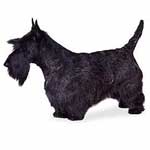
Jamie hones in on Claire like a beacon bringing her his mother’s Scotch pearls. Question #21 is a bonus question! Yesssss, a chance to get extra credit!
Q #21: Name the structure deep to the skin groove at tip of the red arrow. (Anatomy Lesson #16)
A #21: Inguinal ligament. Good work! Here is a reward for “giving us a wee bit of fun”…a regal Scottish stag.
Jamie, you dear, dear man: you really know how to turn a lassie’s head! Claire now that is a string of pearls – not that balderdash you fussed about at the beginning of episode 107 comparing your life with Frank to a string of pearls.
Here’s our last image: the cutest pair of she + he knees I ever kent. But, don’t fash, we will likely return to this episode for future anatomy lessons.
Our own joy ride is over. Darn! Time to grade your papers. How many icons did you get?:
0-5 badges = A
5-10 badges = A+
10-15 badges = A++
15-20 badges = A+++
15-20 badges + bonus = off the charts!
See: You all got at an A or better because we grade on the curve! (Talk about grade inflation.) Thanks for playing along as we suffered through droughtlander and pined away for April 4th! It’s almost here and then a whole new set of episodes for anatomical dissection!
HALLEULJAH, HALLEULJAH, HALLELUJAH, HALLELUJAH ………HAL …..…LE…..…LU…………JAHHHHHH!
A deeply grateful,
Outlander Anatomist
image creds: Starz, Netter’s Atlas of Human Anatomy, 4th ed., www.netalloy.com, www.kevie.co.uk, www.songerconsulting.net, www.johnnyautomatic.com , www.outlanderlife.com, www.pinterest.com, www.openclipart.com, http://wiki.vanessalionel.fr, http://corenominal.org, http://antumdeluge.wordpress.com/, http://maevevella.com ClipartsofLazur URH, Clipartsofanonymous, www.4vector.com, www.wikipedia
The belly has many synonyms: abdomen, beer belly, breadbasket, girth, gut, guts, insides, maw, middle, midriff, paunch, pot, potbelly, spare tire, stomach, tum, and tummy to name a few. Although not a synonym, there is only one word for Jamie’s belly and that is spectacular! Greetings everyone and welcome to Anatomy Lesson #16: The Anterior Abdominal Wall.
This lesson will explore bones, muscles and skin that comprise the belly along with surface landmarks that you may have observed but didn’t recognized as either important or significant. In this lesson, I use the term anterior abdominal wall or the simpler belly wall and hope that by its end you will enjoy a greater appreciation for its complexity, purpose and design.
Herself refers to the belly many times in her writings, but the verra first time we encounter the term is in Outlander where Claire’s belly rumbles loudly in protest of lack of food (BTW, rumblings or growling by the intestines is due to muscle contraction of the gut wall and is called borborygmi – pronounced BOR-boh-RIG-mee). Our ever gallant hero offers her a strong drink (Starz episode 1, Sassenach):
“A moment later, a hand with a flask came around in front of me again. “Better have a wee nip,” he whispered to me. “It willna fill your belly, but it will make ye forget you’re hungry.” And a number of other things as well, I hoped. I tilted the flask and swallowed.”
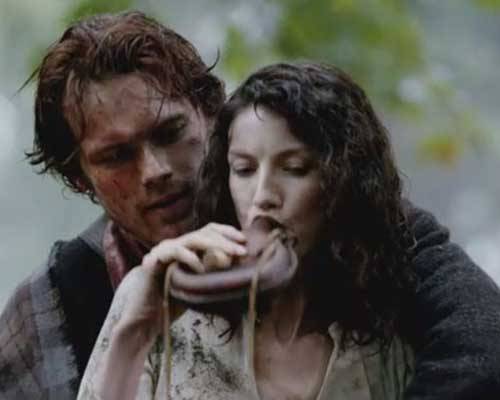
The first time we see Jamie’s belly is Starz episode 2, Castle Leoch after Claire uncovers his back to properly clean and dress his gunshot wound. A number of important surface features are wonderfully demonstrable on Jamie’s belly but in the words of Dougal, we’ll puzzle those out later. One look at Jamie’s bare torso and is it any wonder Claire drops her cleaning cloth? Gah!
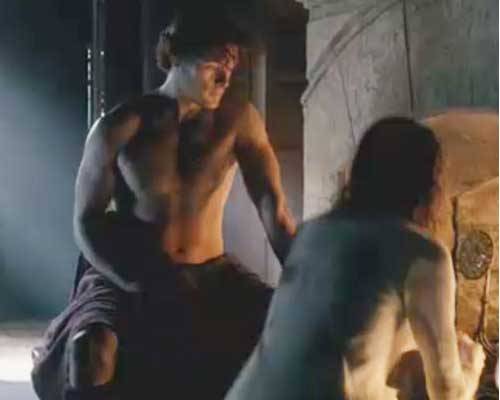
But the first time we read about Jamie’s belly is in Outlander book as Dougal tells Claire about BJR’s flogging of Jamie. Herself writes:
“His mouth tightened up and he says, ‘I thought this was the young man who only a week past was shouting that he wasn’t afraid to die.Surely a man who’s not afraid to die isn’t afraid of a few lashes?’ and he gives Jamie a poke in the belly wi’ the handle of the whip.”
Weel, this looks a wee bit more serious than a poke. The sadistic bastard punches Jamie very hard in the belly with the handle of his cat o’ nine tails (Starz episode 6, The Garrison Commander).
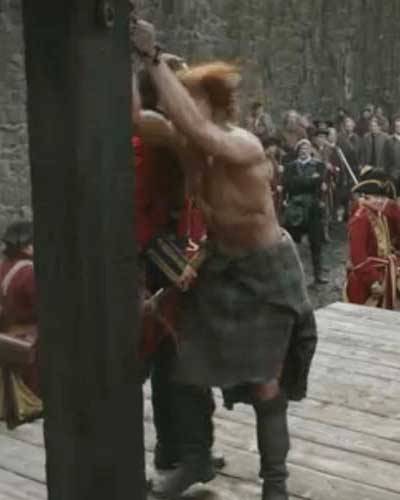
Continuing the quote:
“Jamie meets Randall’s eye straight on then, and says,‘No, but I’m afraid I’ll freeze stiff before ye’re done talking.’ ” In otherwords, quit yer yapping BJR and get on with it! Weel, it was a braw speech for which BJR flogs him even harder.
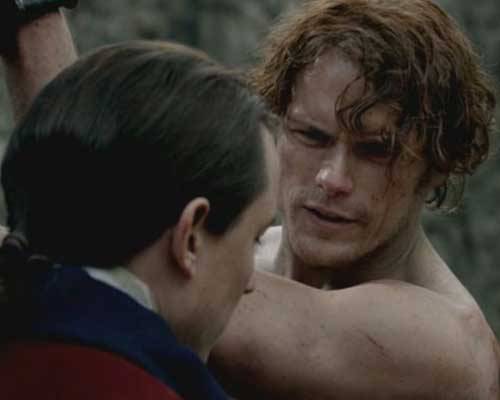
But, let’s leave this sad scene for our anatomy lesson. The abdomen is that part of the trunk between ribs and pelvis (Photo A– blue overlay). Its front and sides are bounded by flexible fibromuscular walls formally known by the lengthy name, anterolateral abdominal wall. As explained earlier, I will use the simpler anterior abdominal wall or belly wall. The posterior (back) abdominal wall is bulkier and less elastic but it doesn’t concern us today.
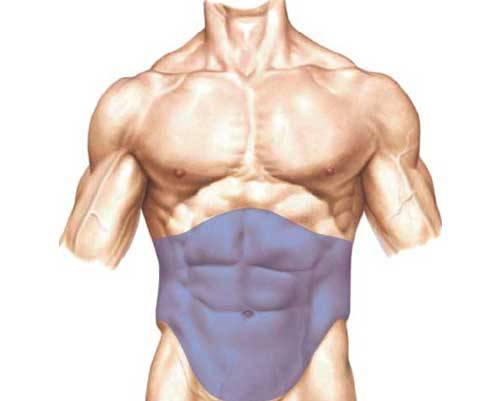
Photo A
The bony framework for the anterior abdominal wall includes xiphoid process and costal margins and parts of the hip bones: anterior superior iliac spine, iliac crest, pubic symphysis and pubic tubercle.
These bony landmarks are often palpated during physical examination. If you read Anatomy Lesson #15, you have already found xyphoid process and costal margins (Photo B – red arrows).
Try this: If you can, lie on your back and relax the tummy. At your sides, locate the point of each hip bone; these are the anterior superior iliac spine or ASIS (Photo B). From the ASIS, press fingers backward along the flared iliac crests. Next, place fingers on the navel and move down to the tops of the pubic bones. You may feel a midline indentation or pubic symphysis, a disc of specialized cartilage that binds together the paired pubic bones; this disc softens during pregnancy. Run fingers along the top of one pubic bone until you feel a smallish bony knob, one of the paired pubic tubercles.
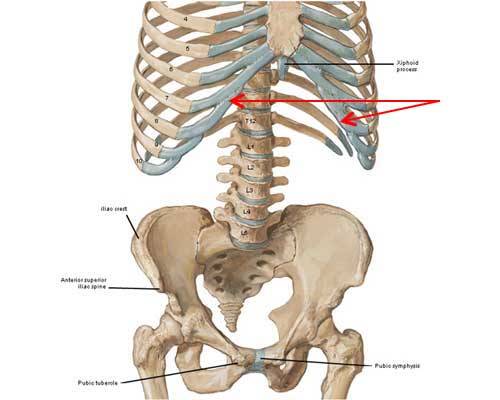
Photo B
The abdominal walls form a flexible and dynamic container for the abdominopelvic cavity which is more extensive than the abdomen because it reaches from the domed thoracic diaphragm above (Photo C – red arrow and Anatomy Lesson #15) to the sunken pelvic diaphragm (floor) below. The cavity contains most digestive and urogenital organs and is subdivided into upper abdominal cavity (yellow in Photo C) and lower pelvic cavity (Green in Photo C). The abdominopelvic cavity is lined with peritoneum, a serous (wet) membrane that clings to inner walls of the cavity and covers organ surfaces. In males, the peritoneum is a closed sac but in human females the sac has two openings one at the mouth of each uterine tube to allow passage of ova.

Photo C
The belly wall may seem simple but it is very complex and critical for our well being. A simple note about orientation before we dissect the belly wall: in anatomy and medicine right (R) and left (L) are defined as the patient’s R and L and not those of the viewer.
Viewed in cross-section (penny-sliced), the belly wall is composed of several tissue layers. The outer layer is belly skin and the innermost is peritoneum (Photo D). Belly skin bears a number of important landmarks we will discuss shortly. Jamie is our model for that. He is always soooo willing. Thank you Big Ruadh One!
The belly wall includes four pairs of muscles known at the gym as abs. Paired rectus abdominis (RA) muscles flank the midline. Each side has three flat muscles from superficial to deep: external
oblique (EO), internal oblique (IO) and transversus abdominis (TA).
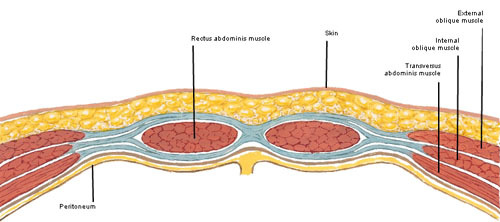
Photo D
The bluish structures in Photo E are fibrous tissues of the belly wall. These include a midline linea alba (Latin meaning white line) and the paired rectus sheaths. Let’s take a closer look.

Photo E
Photo F, shows a superficial dissection of the belly wall exposing linea alba and R rectus sheath. Linea alba is a midline fibrous line. Each rectus sheath is a fibrous envelope extending from ribs above to pubic bone below. The following explains their anatomy: at the mid-clavicular line (Photo F – dashed red line) EO, IO and TA change from muscle to flat fibrous sheets. These sheets envelope each RA muscle as a rectus sheath. In the midline, the sheets meet and decussate (crossover) to form the fibrous linea alba. Amazingly, an incision along linea alba allows an almost bloodless entry into the abdominal cavity as only tiny blood vessels cross the midline.
This is interesting: see the structure labelled spermatic cord (Photo F)? Paired spermatic cords suspend the testes (pl.) in the scrotum and contain structures running to and from these organs. You may think it odd to mention spermatic cords in a belly wall lesson but anatomists teach them here because their layers are derived from the belly wall. Each spermatic cord traverses the inguinal canal (not shown) an oblique channel through the wall and then emerges via its respective superficial inguinal ring.
Each spermatic cord contains a testicular artery the sole blood supply to the testes (This lesson ends with a cautionary tale about the testicular artery. Stay tuned!). Spermatic cords also contain the all-important vas deferens, a small muscular tube for passage of spermatozoa…called the vas deferens because it makes a vast difference if accidentally cut! Um, couldn’t resist a beloved “joke” amongst surgeons.
Lastly, testes do not develop inside the scrotum, they develop inside the abdominal cavity. During the last trimester, they descend through the inguinal canals and exit the superficial inguinal rings to reside within the scrotum. Females also have paired inguinal canals although each contains an unimportant (as far as known) fibrous ligament. Importantly, the inguinal canal is the channel through which passes an indirect inguinal hernia; more common in males.
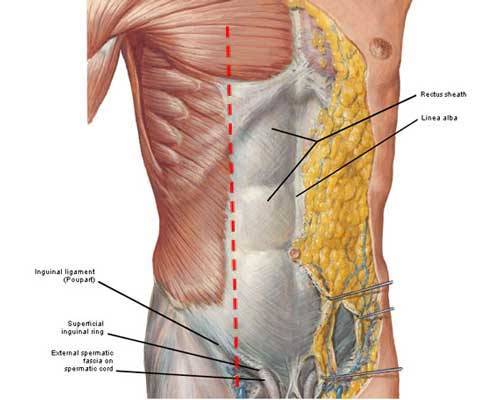
Photo F
I am breaking my own rule in this lesson by using an image of Graham McTavish because I havna got one of Dougal with his shirt off. Big D is sooo modest in the Starz series. So let’s pretend that this is fierce Dougal (Photo G). The red arrow marks the location of Dougal’s verra fine linea alba. Hopefully this will, erm, satisfy some readers who beg for more Dougal anatomy.
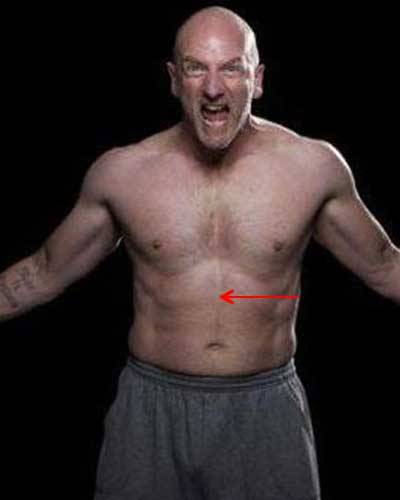
Photo G
I canna show Dougal-Belly and not show Frank-Belly. Now then Frank, “fair’s fair…take off yours, too.” Ha! Not too many surface features are visible here because Frank is seated, but we can see the location of his linea alba (Photo H):
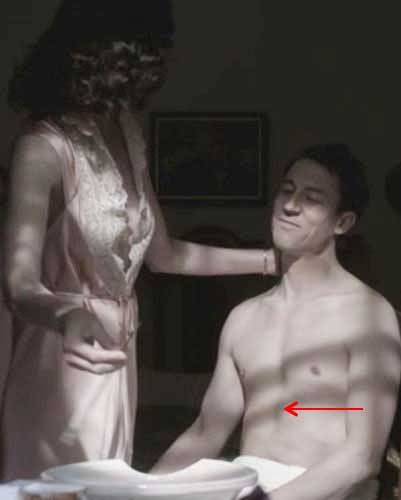
Photo H
Next, let’s examine muscles of the belly wall, all of which support our abdominal organs. Beginning at the sides, the most superficial pair is the external oblique (EO); each arises from the ribs (Photo I), turns tendinous, helps form the rectus sheath and inserts into linea alba, pubic tubercle and inguinal ligament. Whew! EO muscle fibers are directed downward and towards the midline.
Try this: place hands in the side pockets of jeans or similar trousers; the fingertips point the same direction as EO muscle fibers. Working together, EO muscles flex the trunk and compress the abdominal viscera. Working independently, each EO helps rotate the trunk.
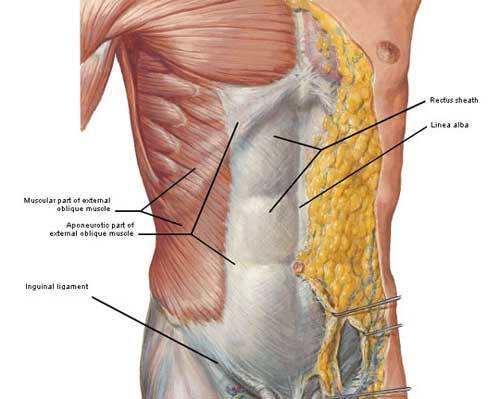
Photo I
Deep to each EO is an internal oblique (IO) muscle. Each IO arises from thoracolumbar fascia (Anatomy Lesson #10) and iliac crest, turns tendinous, helps form the rectus sheath and inserts into linea alba, pubic tubercle and inguinal ligaments (Photo J). Most IO muscle fibers are directed upward and towards the midline (90° to EO muscle fibers). Working together IO muscles flex the trunk and compress the abdominal viscera. Working separately each IO helps rotate the trunk.
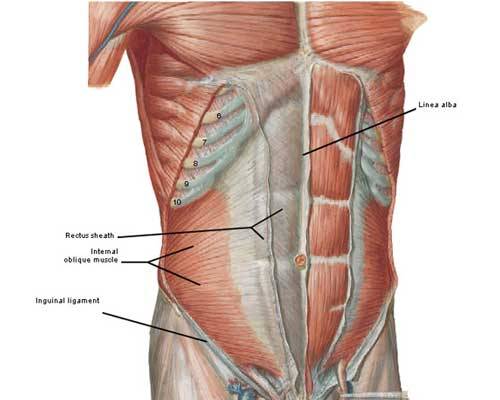
Photo J
Interestingly, when rotating the trunk as in cross crunches (Photo K) EO of one side works with IO of the opposite side. Here, left EO contracts with right IO to rotate and flex the trunk toward the
right knee. Note: when doing cross crunches, one should reach shoulder/arm pit (not elbow) toward the opposing knee.
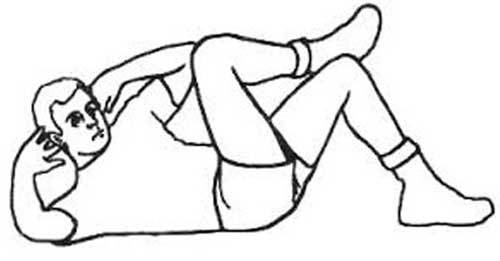
Photo K
Deep to each IO is transversus abdominis (TA), deepest of the side muscles (Photo L). TAs arise from costal cartilages, thoracolumbar fascia, iliac crests and inguinal ligaments and insert into linea alba and pubic bones. TA muscle fibers are horizontal and like EO and IO give way to a flat tendon that helps form each rectus sheath and linea alba. TA compresses and supports the abdominal viscera. They can be strengthened by doing exercises that tighten the belly wall (e.g. Pilates).
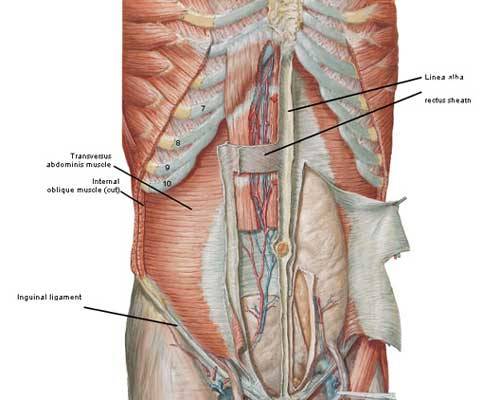
Photo L
Our final set of abdominal muscles is the paired rectus abdominis (RA); each is a flat vertical muscle extending from pubic bones to costal cartilages (Photo M) and is enveloped by its respective rectus sheath.
RA muscles are separated in the midline by linea alba. The lateral border of each RA is marked by a curved line, the linea semilunaris (Photo M – black arrows).
Tendinous Intersections: The grey horizontal bands are tendinous intersections (TIs), fibrous bands that traverse each RA. Most individuals have three TI per RA. The left RA shows three typical TIs and a partial fourth. Acting together RA muscles flex the trunk and compress abdominal viscera.
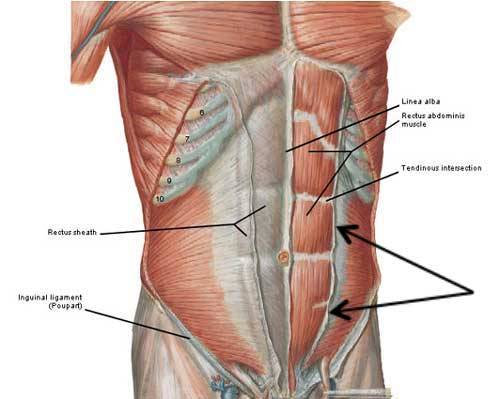
Photo M
If rectus abdominis muscles are well-toned, they bulge between the tendinous intersections accounting for the six-pack appearance of a muscular anterior abdominal wall. The man shown in Photo N has three pairs of TIs and three RA bulges: one set above the top TI, second set between top and middle TI, third set between middle and bottom TI. The belly below the navel is
not part of a six-pack.
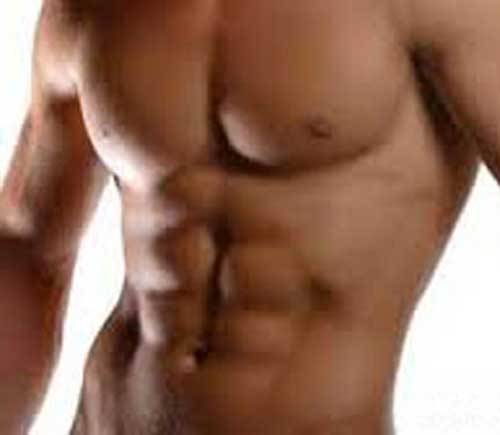
Photo N
Occasionally, a 4th and 5th pair of TIs appears below the navel resulting in an 8- or even more rarely a 10-pack ab. This man has four pairs of TIs – the 4th appears below the navel (Photo O – red arrow)
resulting in an 8-pack. This is not an anomaly, it just represents individual variation.
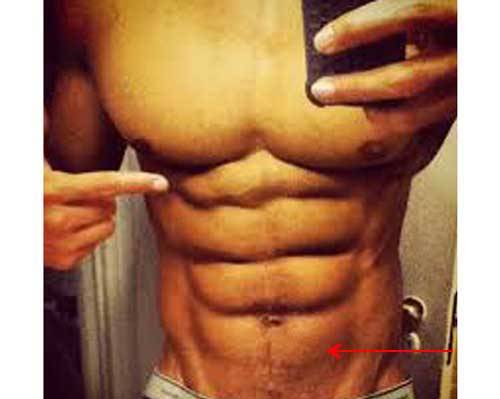
Photo O
TIs may be asymmetrical such that a pair of bands is offset relative to each other. In the image below (Photo P – red arrows) both woman and man have stair-step TIs. Again, this is individual variation and has no known functional significance.
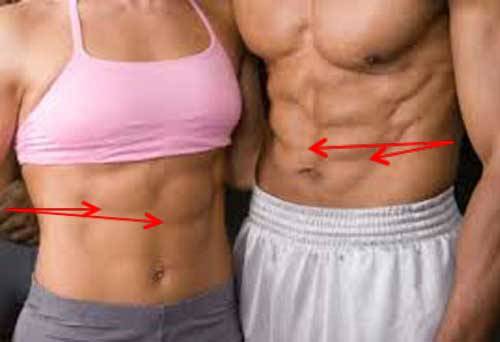
Photo P
Try this: Would you like your own 6-pack abs? Simple crunches help as they employ EO, IO and RA muscles. Crunches may be done many ways but a common method is to bend the knees with feet hip
distance apart and resting on the floor, elbows to the sides, hands resting lightly behind the head (Photo Q). Lift shoulder blades off the floor and repeat many, many, many times. But, more importantly for protection the lower back (lumbar region) remains on the floor and do not pull on the neck.
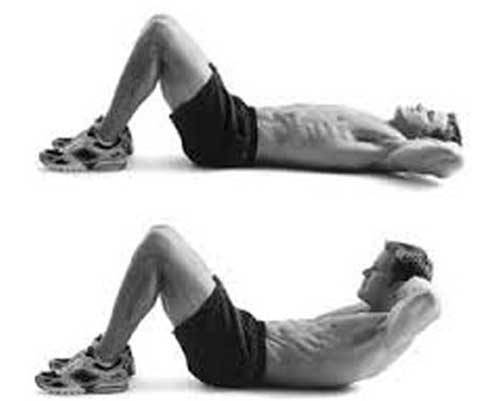
Photo Q
Now, for surface anatomy: Belly skin bears a number of topographical landmarks which are best observed in the lean and/or physically fit.
First, a vertical midline groove or furrow overlies the fibrous linea alba (Photo R) marking the medial border of each rectus sheath and its enclosed RA muscle.
Next, the umbilicus, navel or belly button lies near the center of the belly wall at the level of L3
– L4 IV disc (Anatomy Lesson #10). The umbilicus is a midline cicatrix or scar that marks the
attachment site of umbilical cord to body wall during prenatal life. Its size and shape vary considerably and with increased weight or distortion from pregnancy its placement may change. Although most human have an umbilicus, some do not. People may require surgical removal of the umbilicus due to herniation, birth defects, injury and infection or for elective cosmetic reasons.
The umbilicus bears a small opening or umbilical ring. Try this: Lie on your back, place a fingertip in the center of the umbilicus and press down. You may feel the small tight opening of the umbilical ring through which passed the umbilical vessels during intrauterine life.
Two curved vertical skin grooves are also visible on belly skin; lineae semilunares (Latin meaning half-moon lines) mark the lateral border of each rectus sheath and its enclosed RA muscle. These extend from costal cartilages to pubic tubercles.
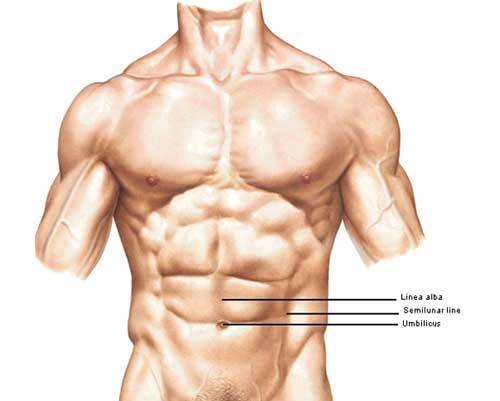
Photo R
Time for a Jamie-fix! Does Jamie’s belly show these surface features? Oh, aye, to be sure. The red arrow (Starz episode 2, Castle Leoch) points to the vertical furrow overlying linea alba. Ahhhh, now readers, quit looking at Jamie’s chest! I ken what ye are thinking. We are supposed to be
learning the belly wall. Erm, Clarie keep hold of your cleaning cloth!
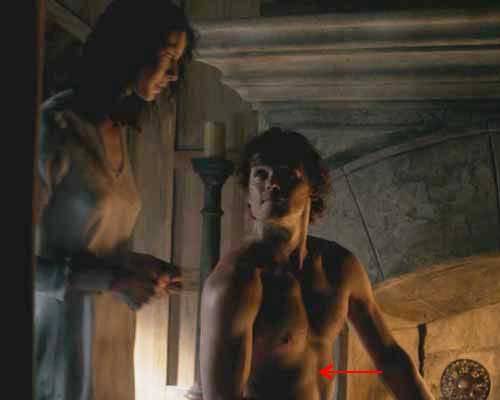
Here Jamie is suspended from ropes as the Mad Man of Fort William beats him the first time (Starz episode 2, Castle Leoch). The red arrows point to medial and lateral margins of the L rectus sheath which is tightened because he is hanging by his arms. Because both rectus sheaths are taut his tendinous intersections and rectus abdominis muscles are flattened. The point is this extended position stretches of his belly wall and its associated structures. No need to ask about his navel, I’ll tell ye: it is a little to the right because his hips are slightly twisted. Jamie has just spit, whether from pain or disgust or both, it’s a verra manly gesture and I love it! Ye can see three drops of spit falling near his navel.
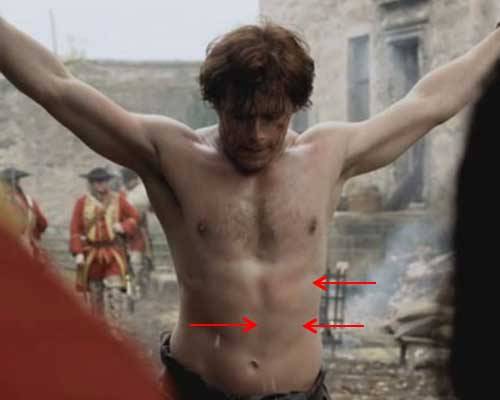
Keen observation also reveals Jamie’s L linea semilunaris (red arrow) marking the lateral margin of the same rectus sheath (Starz episode 2, Castle Leoch). Now Jamie, I’m not sure Claire is paying heed to your warning about being English in a place where that’s not a pretty thing to be –
appears to me that she canna stop looking at your belly wall and neither can we! Yeow!
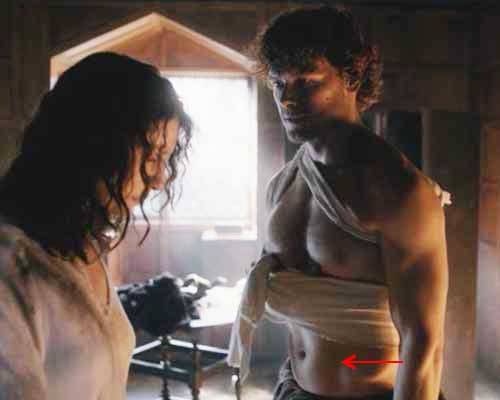
We’ll leave Jamie for a moment but dinna worry he’ll be our model again soon. Two other surface landmarks are pertinent to today’s lesson (Photo S). A toned belly shows three pairs of horizontal skin grooves. Each groove overlies a tendinous intersection of RA muscles. Remember, a well-developed RA bulges between the tendinous intersections causing the much-admired 6-pack abs!
Another pair of skin grooves extends obliquely from ASIS to pubic tubercles; these are the inguinal grooves and each overlies an inguinal ligament, marking the boundary between trunk and lower
limb (Photo S).
Try this: lie on your back and relocate ASIS and pubic tubercle. Press fingers about half way between these bony landmarks and feel a thick tough band, the inguinal ligament. Above this ligament is trunk; below it is lower limb.
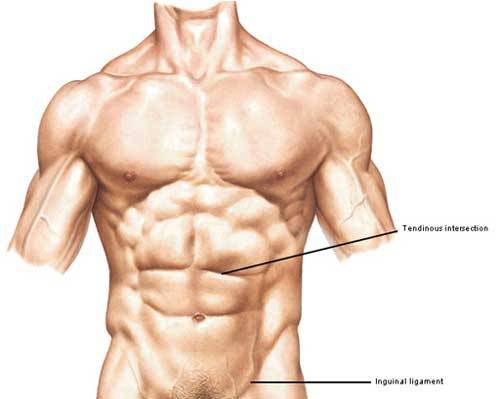
Photo S
Can we see Jamie’s tendinous intersections and does he have a six-pack? Och, aye, here is the Scottish six-pack in all its glory! Starz episode 6, The Garrison Commander shows his fine abs verra nicely. Arrows point to three pairs of tendinous intersections (TIs). To review: the top pair of TIs (red arrow) lies near the xyphoid process; the bottom TI pair (blue arrow) is near the navel; and the middle TI pair (green arrow) lies between the former two. Remember, in the physically fit, TIs divide each rectus abdominis muscle into bulging segments. Although his lower abdomen is covered by his carefully folded shirt, Jamie does not have a 4th pair of TIs (I’m the anatomist. I’m in charge – so I checked!). Snort!
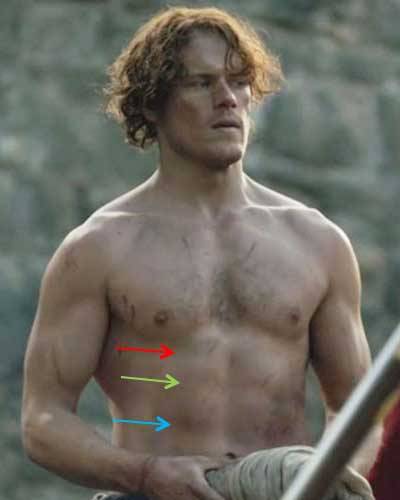
And finally, here is Jamie’s R inguinal groove overlying his R inguinal ligament after being struck by crazy Jack. Because his hips are modestly swathed in plaid we see only the upper half of the inguinal grooves. Wish someone would whip that whip out of Randall’s hands and administer a few smacks to his back.
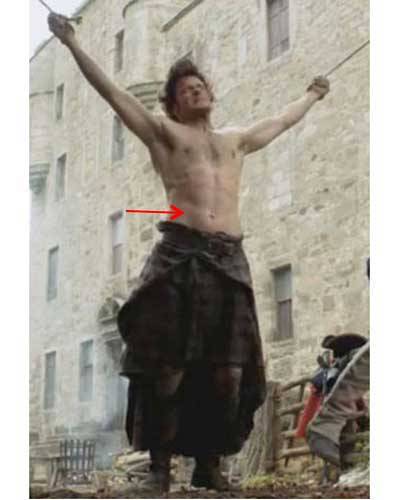
Pop quiz time! Next is an awesome image of Jamie from, well ye all ken where it’s from (Starz episode 7, The Wedding)! And, a lovely quote from the Outlander book:“
‘Because I want to look at you,’ I said. He was beautifully made, with long graceful bones and flat muscles that flowed smoothly from the curves of chest and shoulder to the slight concavities of belly and thigh.”
Woo hoo, are ye paying attention? Slow deeeeeep breaths! All five topographical features of belly
skin can be seen in this image:
Did ye find them? Would ye like to find them? Ha ha! Hopefully ye all got 100%.
Tcha, Jamie. Didna your mother, Ellen, teach ye not to stare? Gie the puir lass a break! (It’s OK if we stare though.)
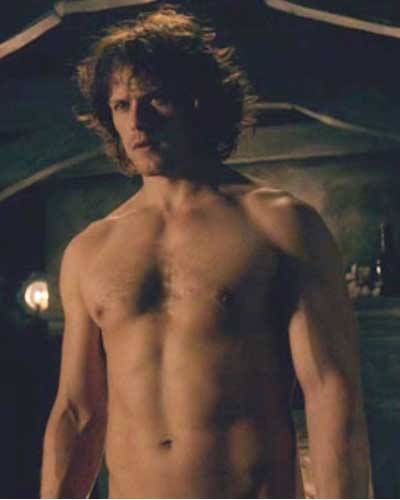
Sigh. Aye, it’s time to leave Jamie. Bye. Bye.
Now, for the promised true story…some years ago, I had delivered my yearly lecture to first year
medical students on anterior abdominal wall, spermatic cord, etc. A few weeks later, a student shared with me the following harrowing experience. He had just run in the New York Marathon (Photo T – student is not in photo). Weather was warmish and he decided to run wearing only nylon vest and running shorts. After running a few miles, he suddenly crumpled in agonizing pain and
immediately diagnosed his own problem (aye, he remembered the lecture!): as body heat increases, spermatic cords and scrotum relax allowing the testes to move more freely than usual.
His right testis shifted enough during the run to twist its spermatic cord thus strangling the testicular artery and cutting off blood flow. Known as testicular torsion, this is a true surgical emergency that can result in loss of the affected testis if not treated promptly. Paramedics took him to an emergency room where ER docs moved the testis to untwist the spermatic cord and restored its blood supply. Although this may sound slightly frivolous, it is not. Having seen pathology specimens of necrotic (dead) testes following torsion, it is a shocking sight as this organ cannot tolerate loss of its oxygen supply!
I congratulated him on the outcome of quick medical intervention. Needless to say, my future lectures included this prime example of a choice gone wrong (yes, he gave permission – with no identifiers). Men must take precautions to wear appropriate and supportive undergarments especially if a long run is planned. And just to emphasize the point, torsion is the most common cause of testicular loss in adolescent males!
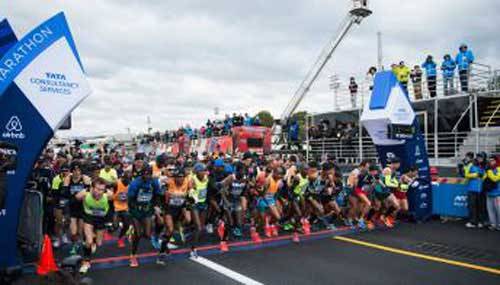
Photo T
Okay, you guy readers can start breathing now! The scary story is over.
I hope ye all enjoyed the verra important anterior abdominal wall lesson and appreciate its complex anatomy. Dinna forget – surface features of a muscular belly wall are based on its underlying anatomy. Fare thee well until my next lesson. In the meantime, please take good care of your amazing body!
A deeply grateful,
Outlander Anatomist
You can now follow me on Facebook and Twitter!
Photo creds: Starz, Gray’s Anatomy,
39th ed., Netter’s Atlas
of Human Anatomy, 4th ed., Clinically
Oriented Anatomy, 5th ed., Hollingshead’s
Textbook of Anatomy, 5th ed., Wikipedia, pixshark, workoutnirvana, simplyshredded, the-fitness-motivator, fitnessversusweightloss, build-muscle-101, wikihow, running.es, popworkouts.